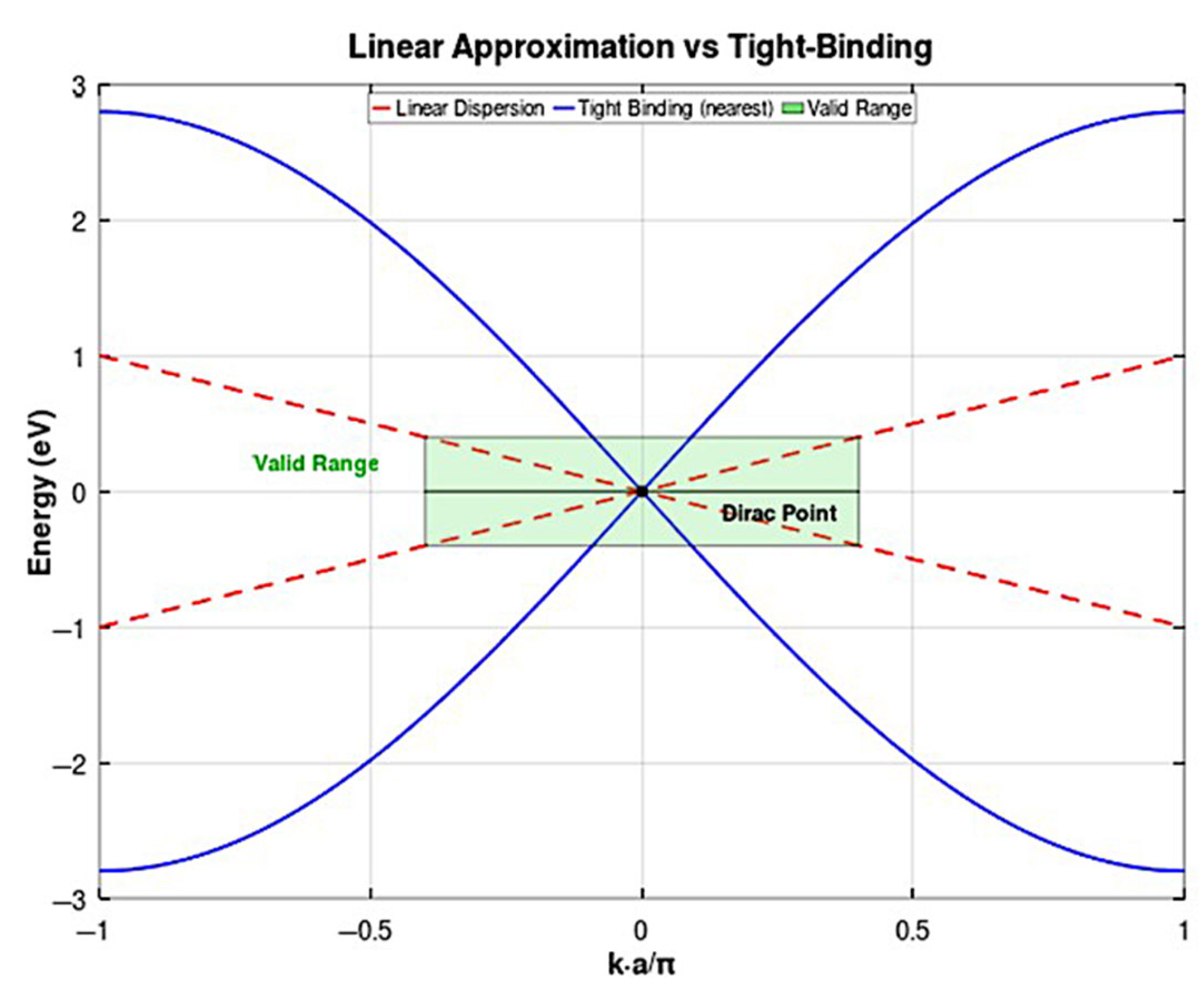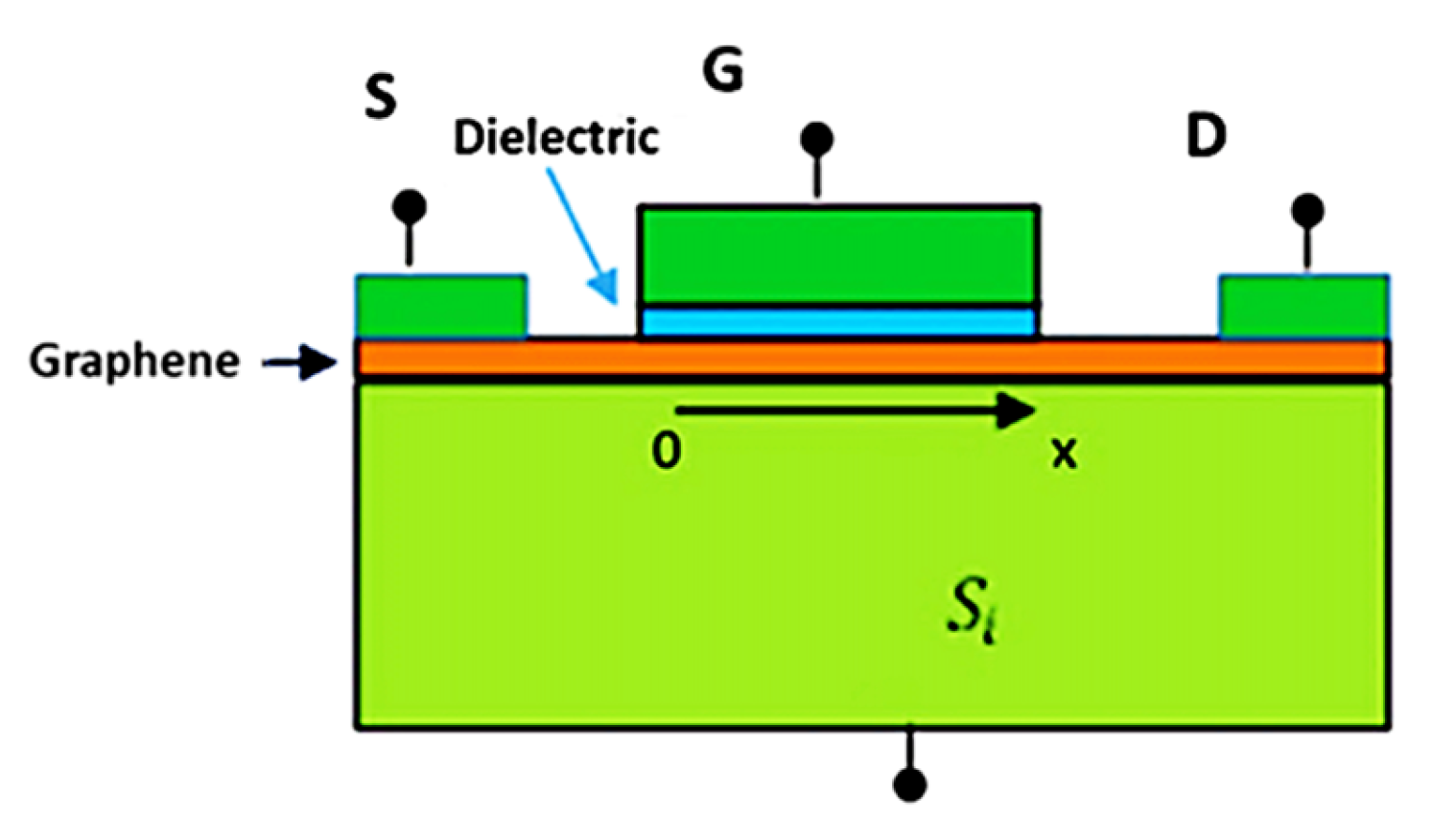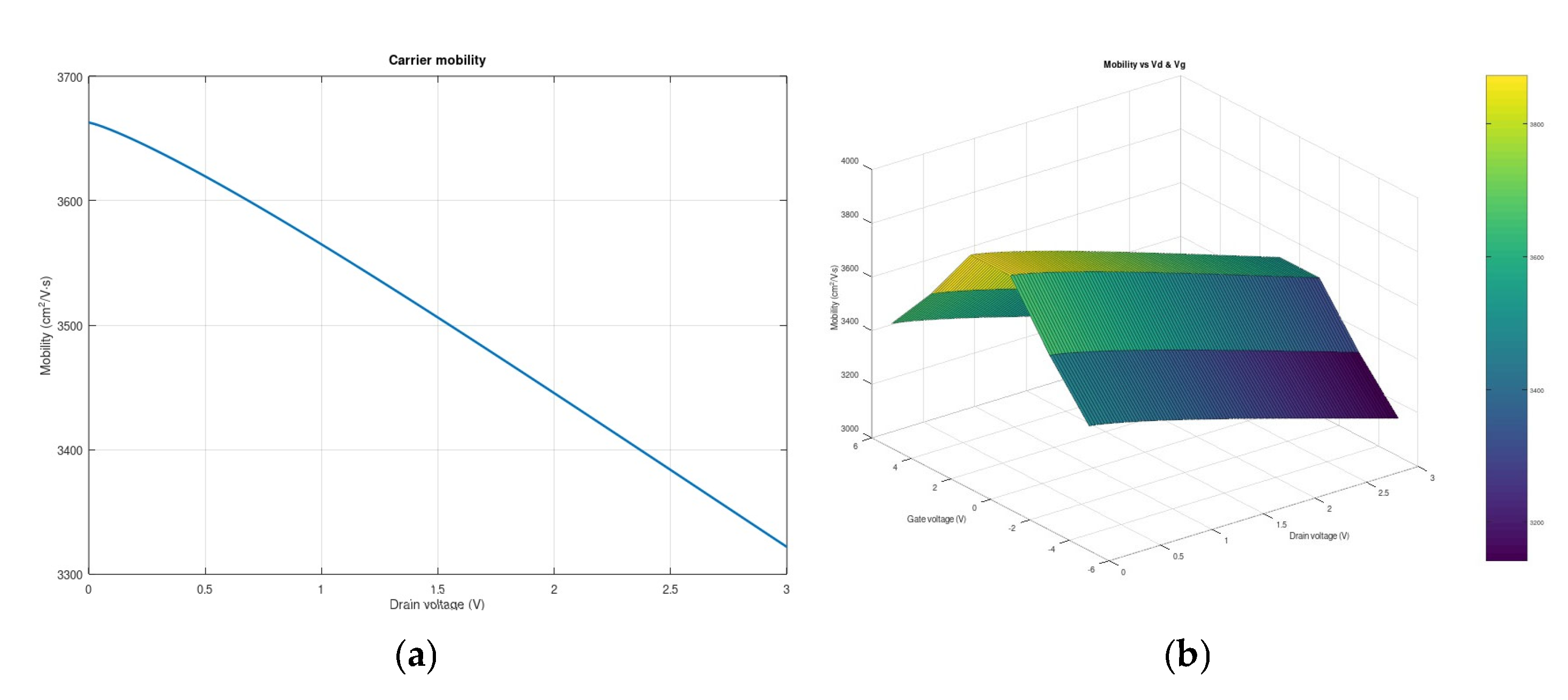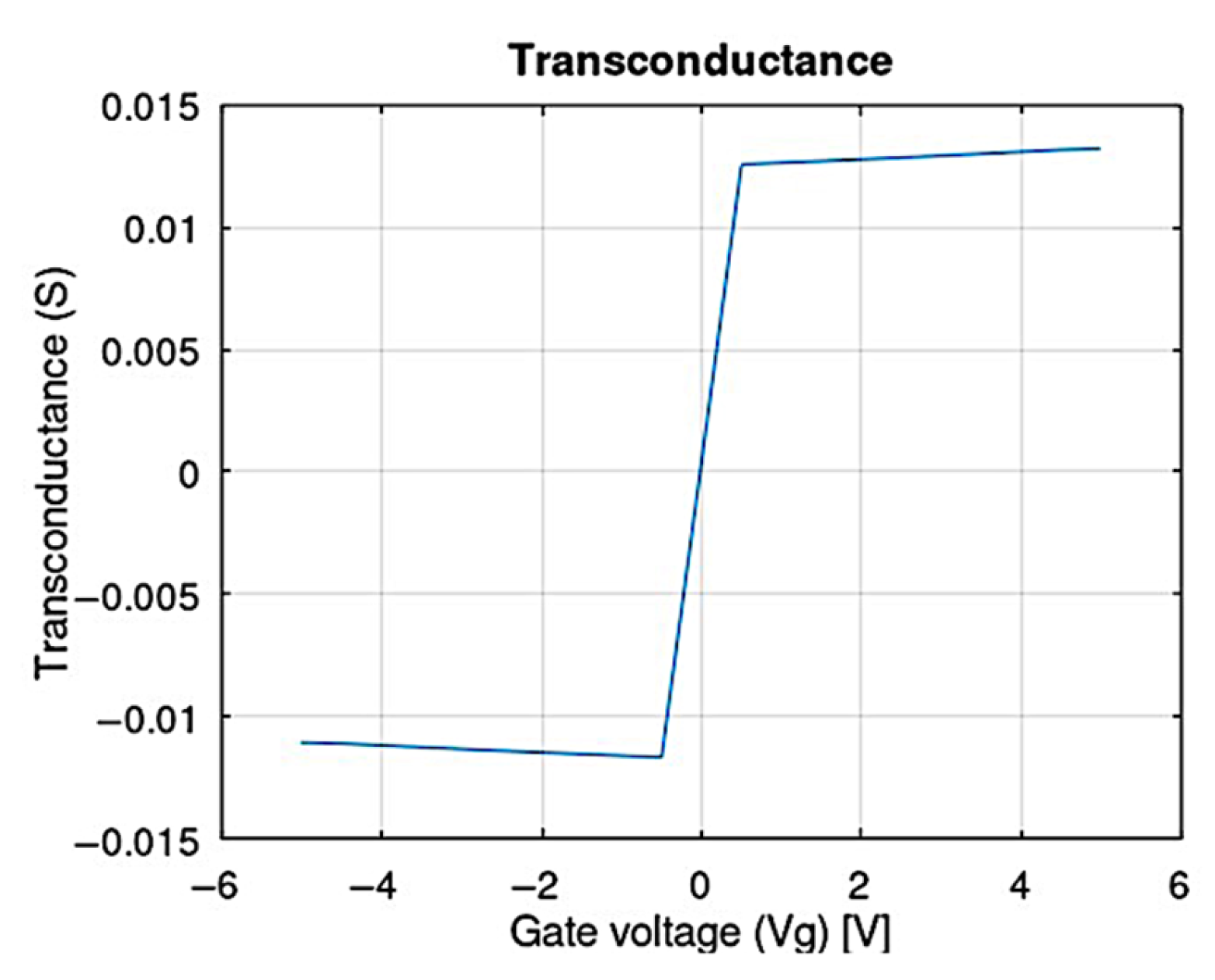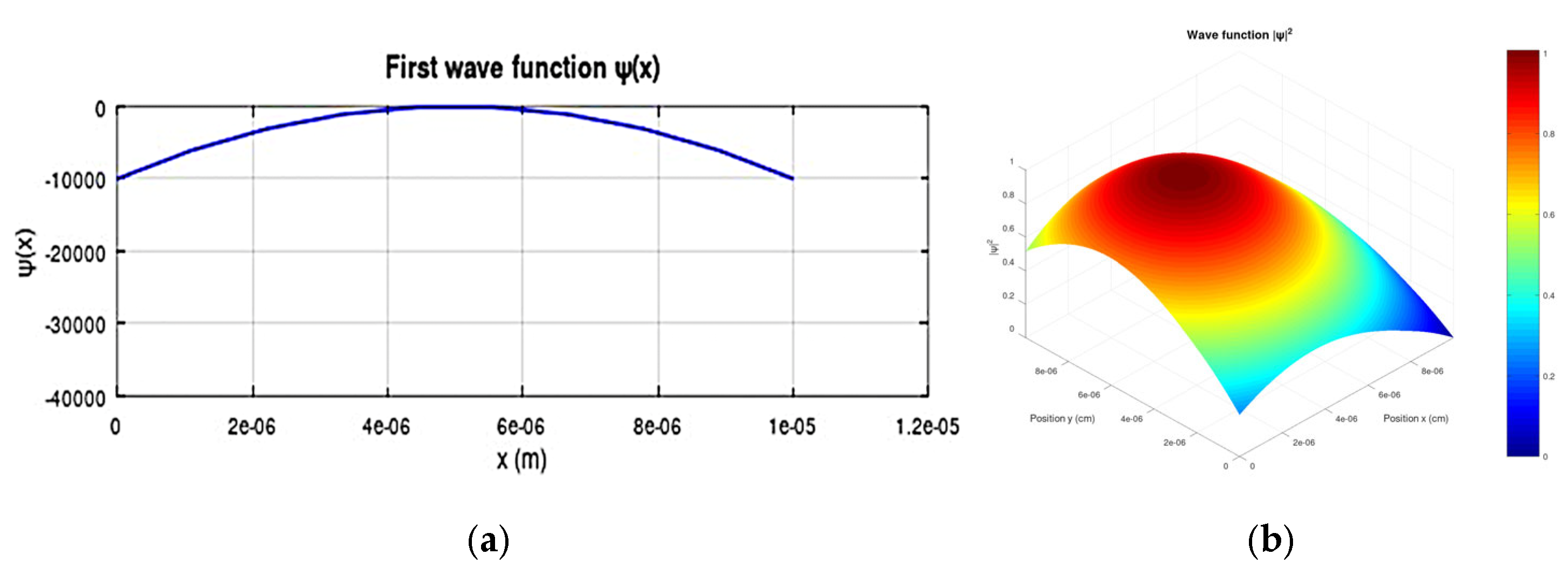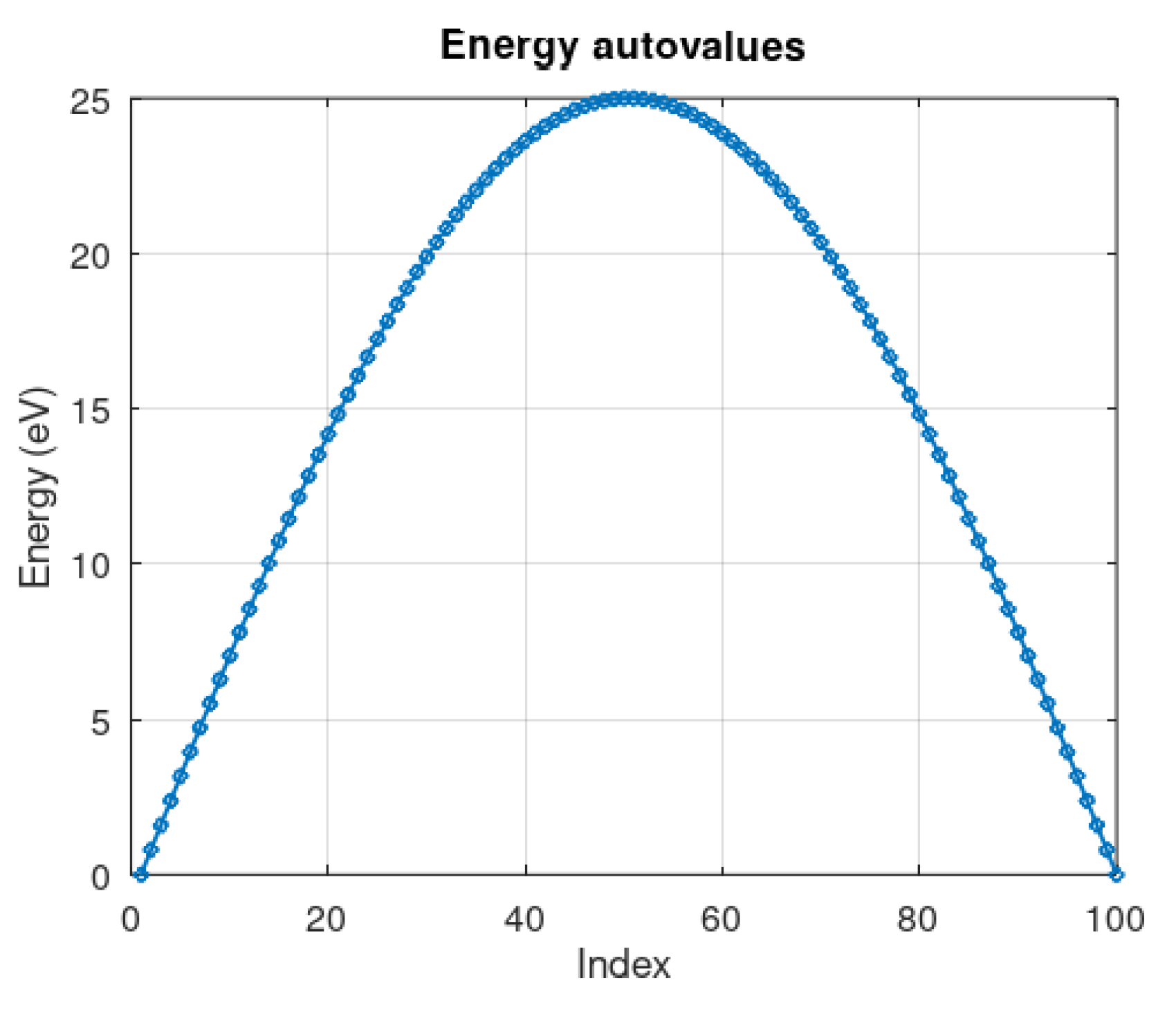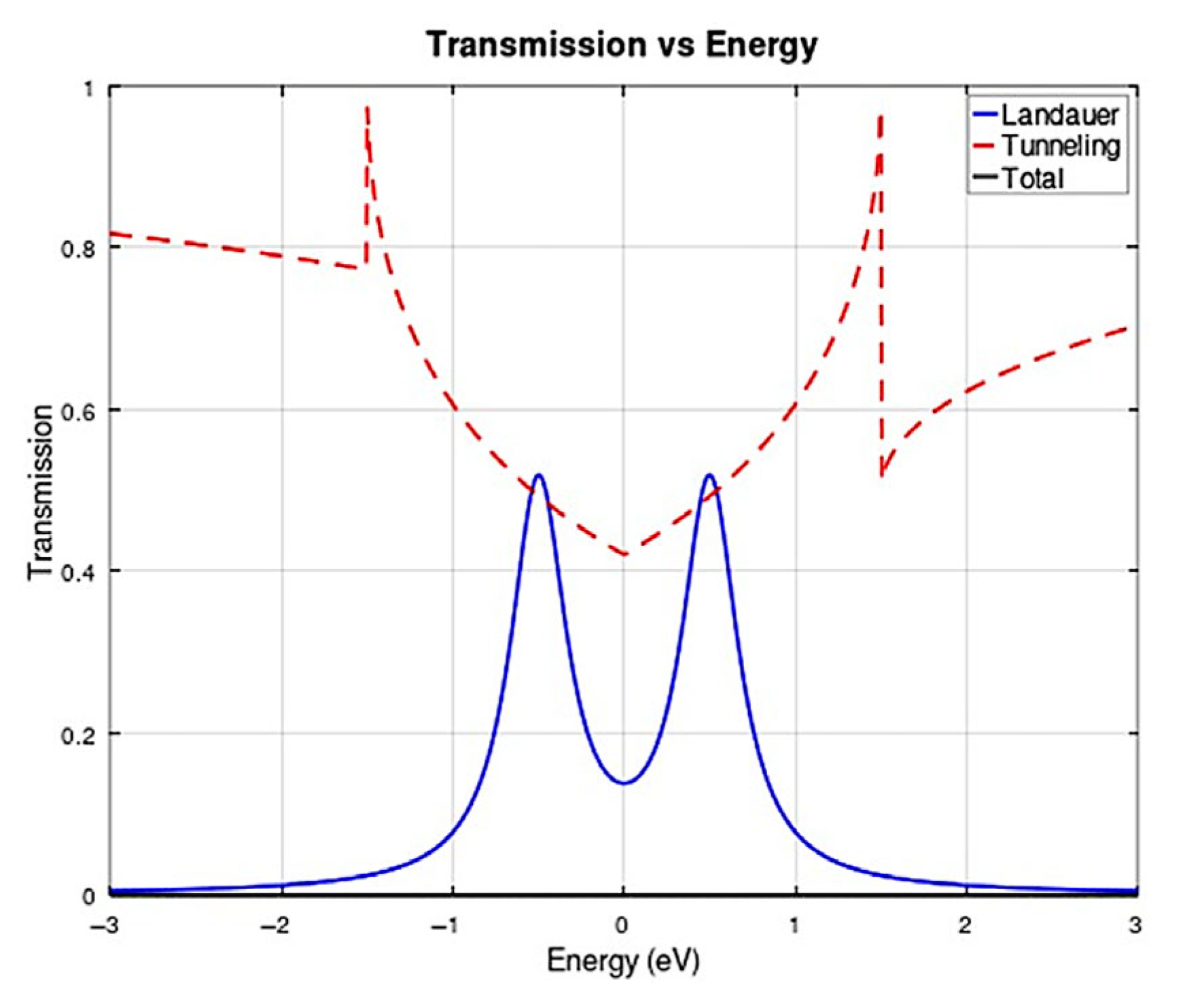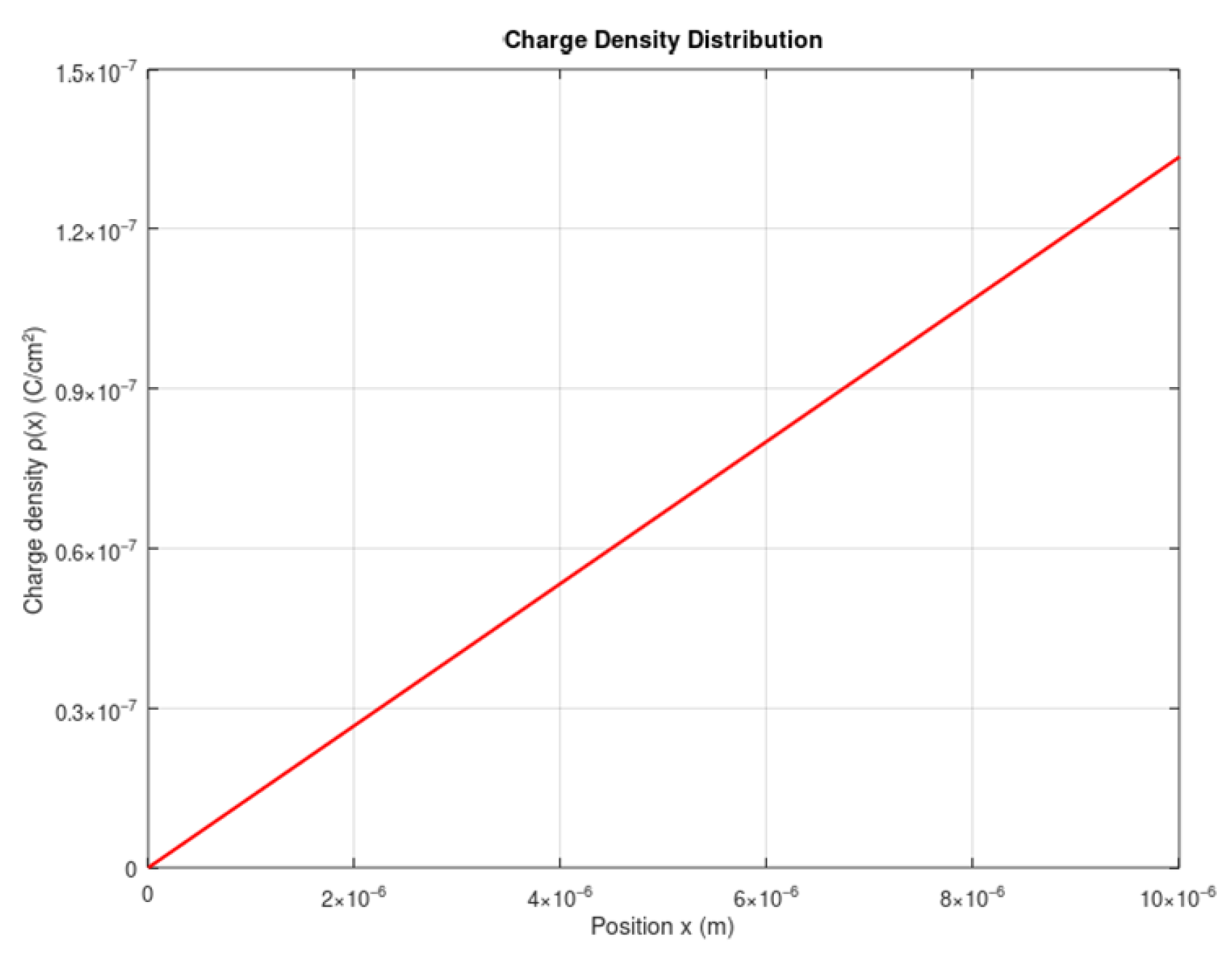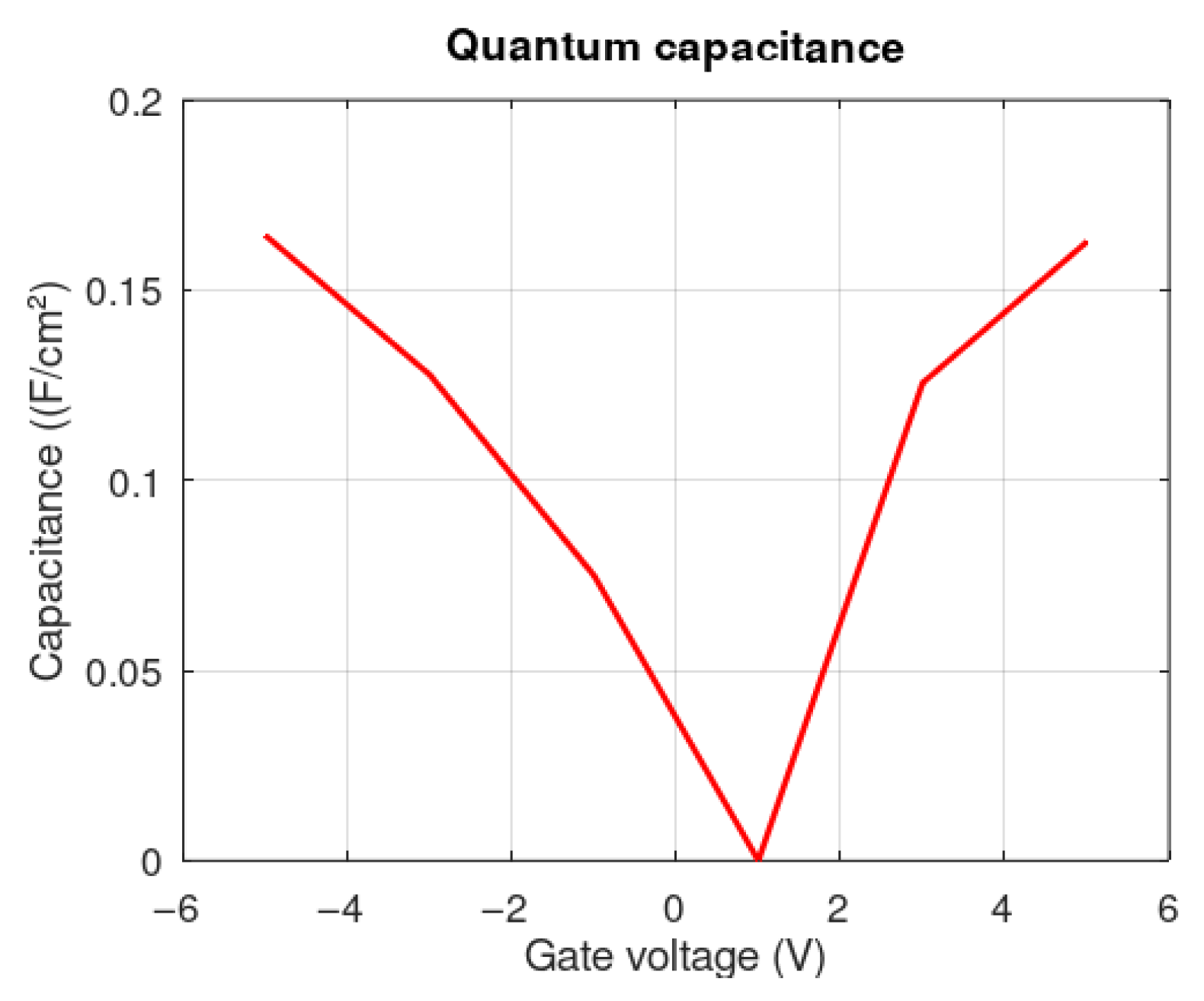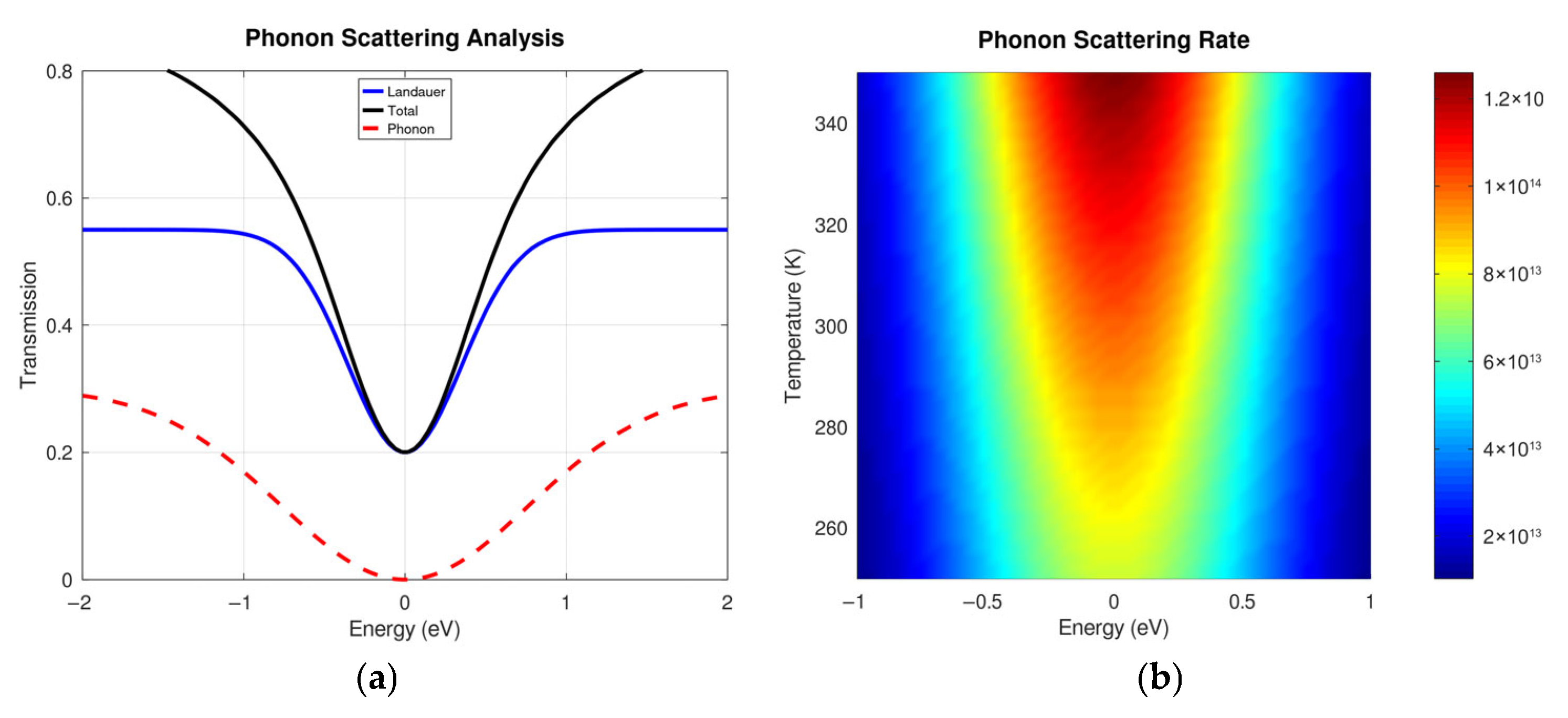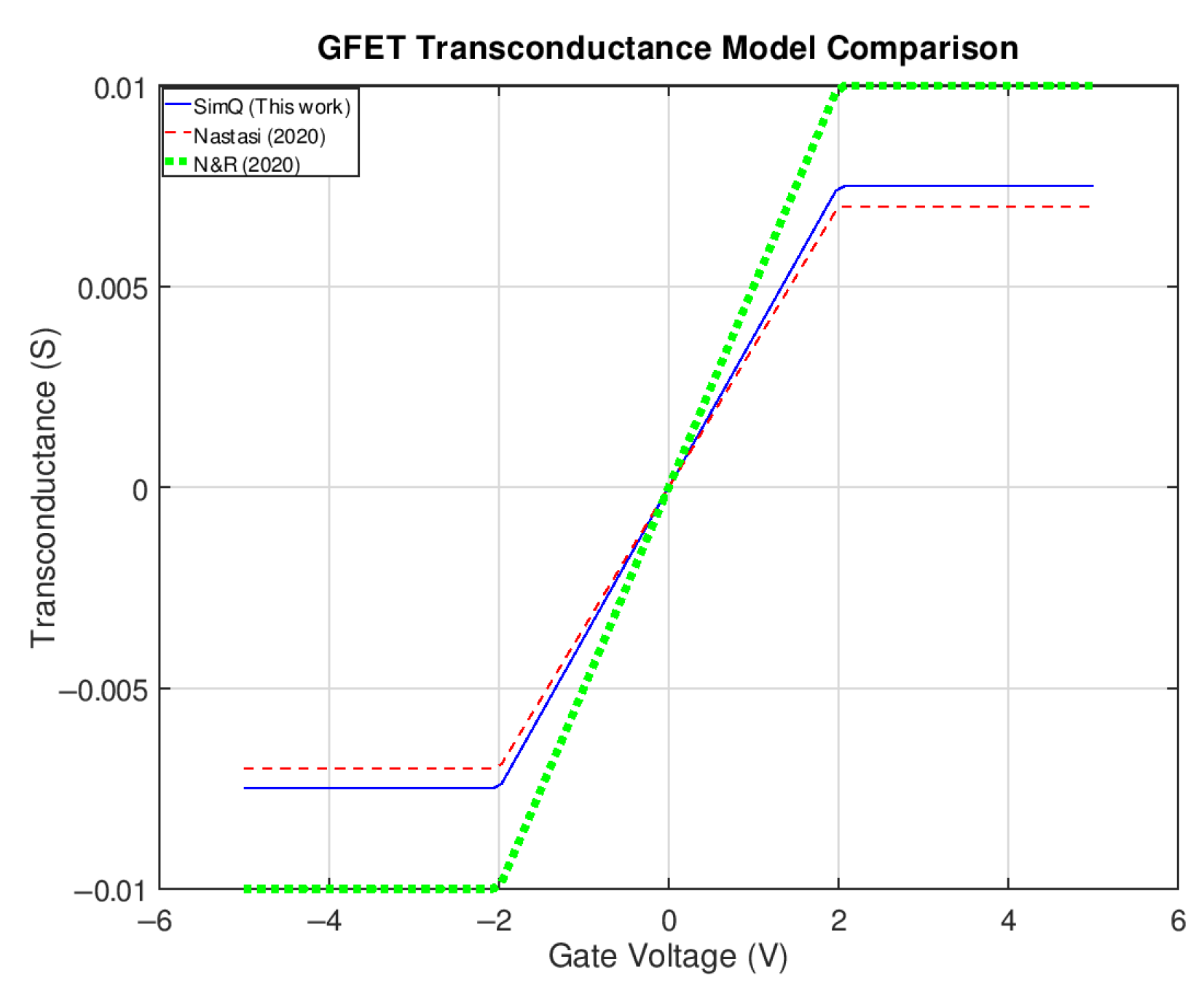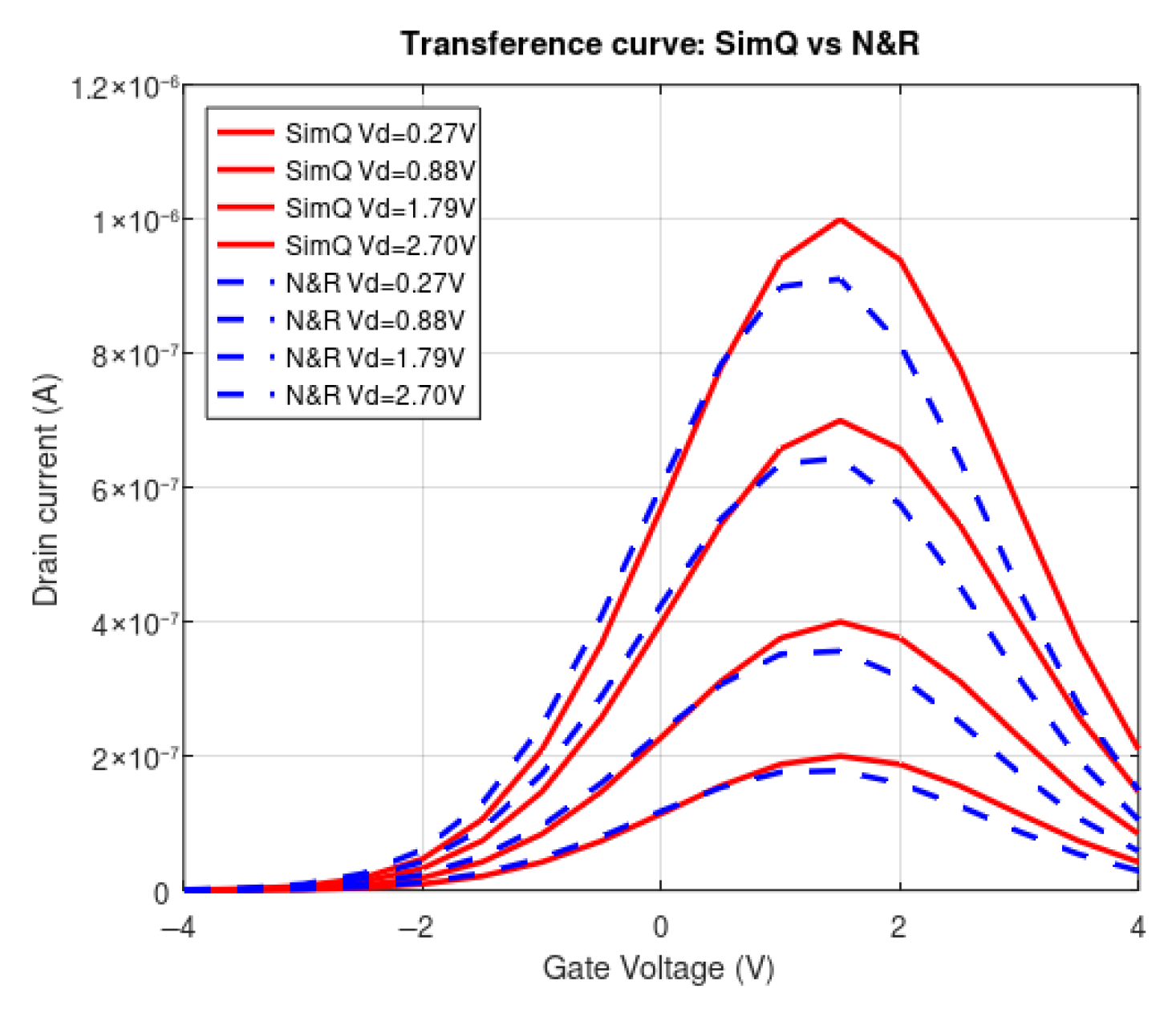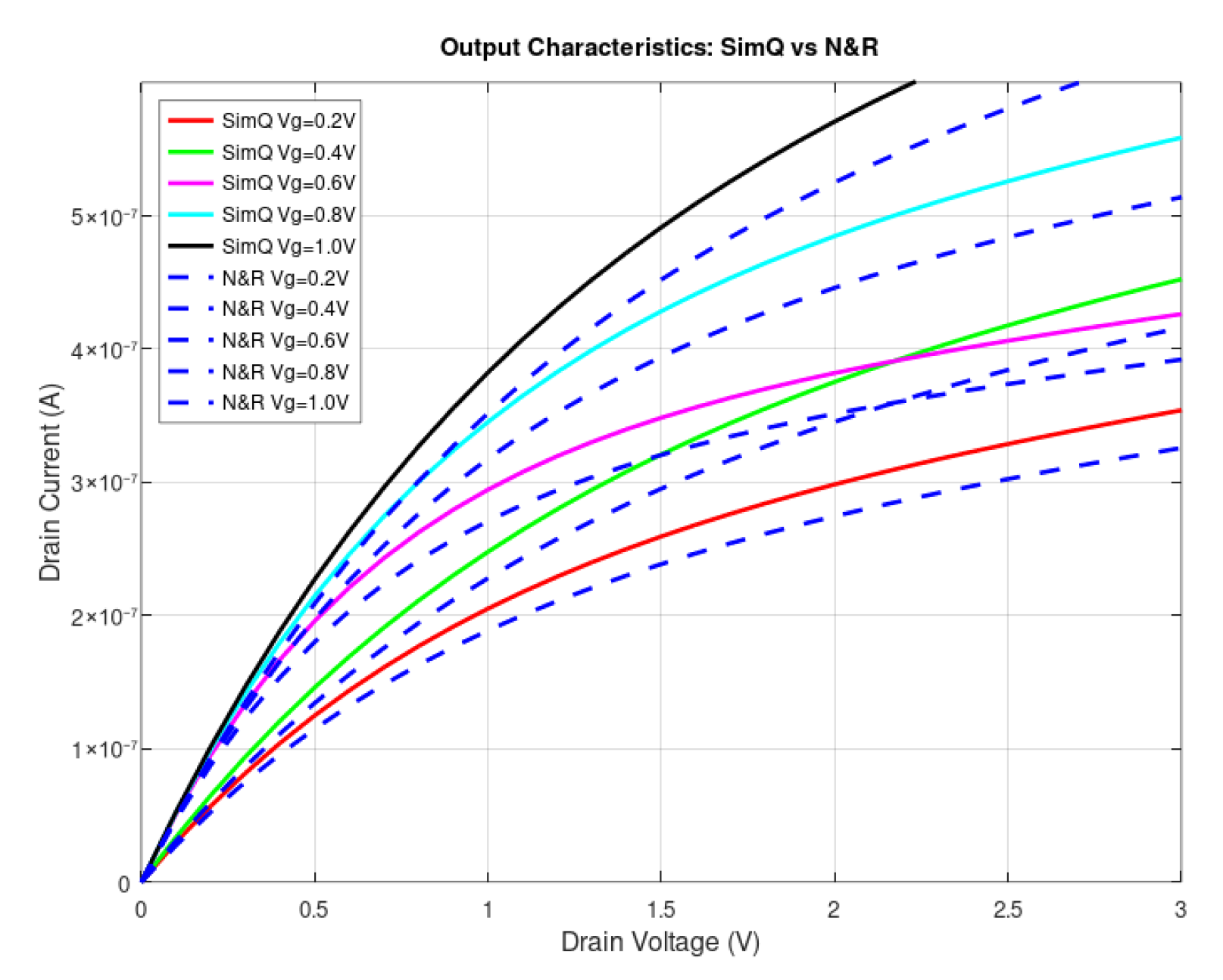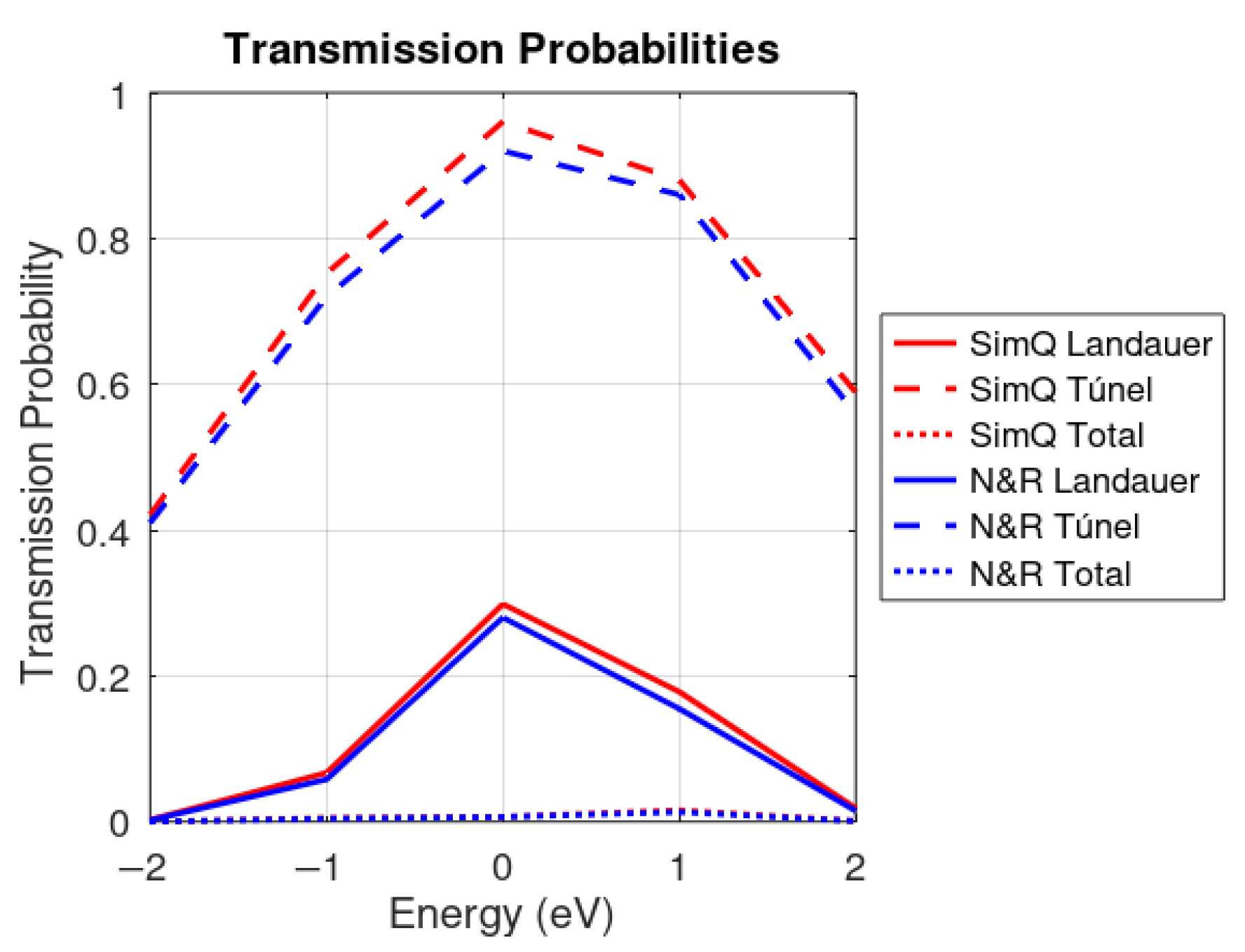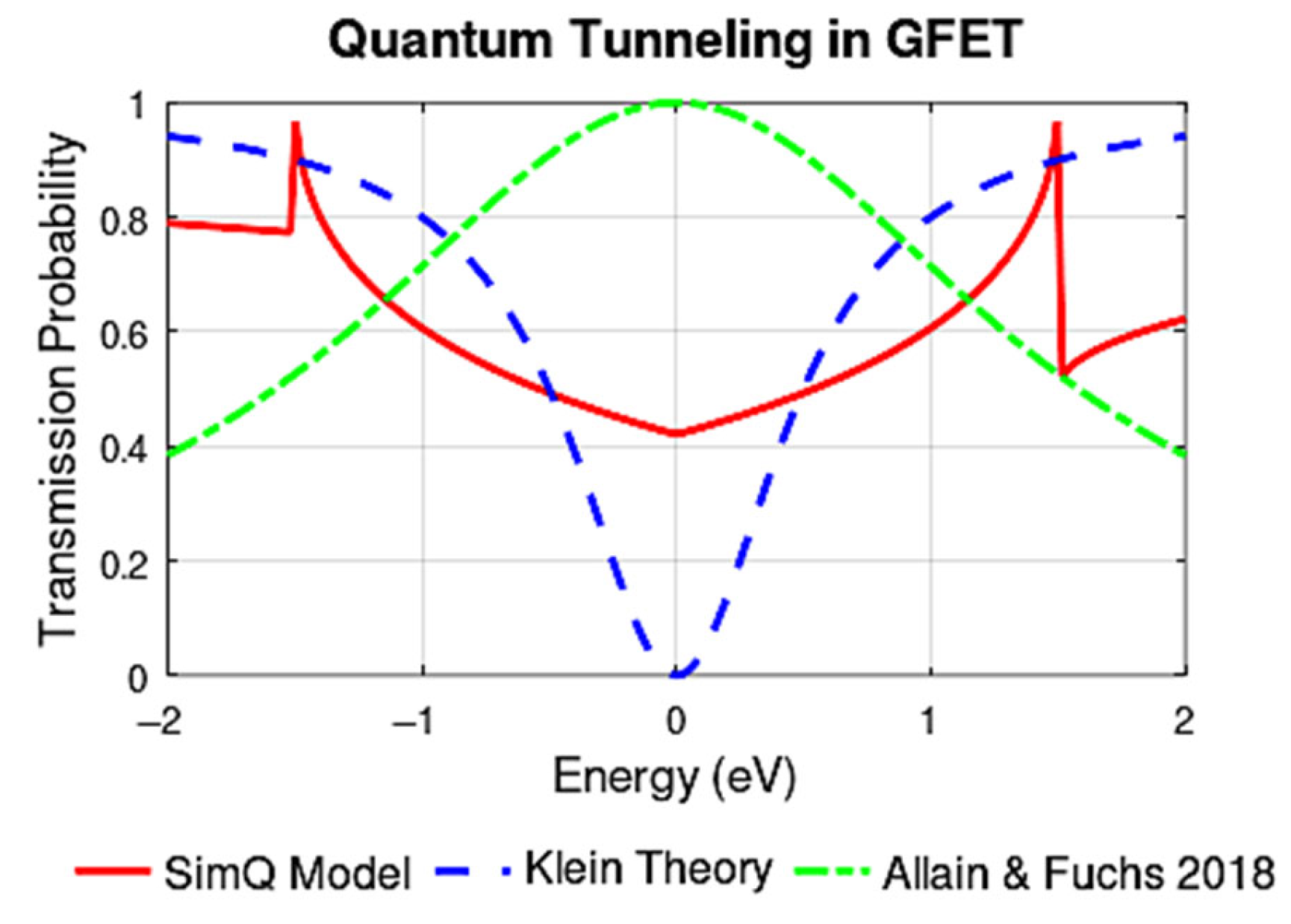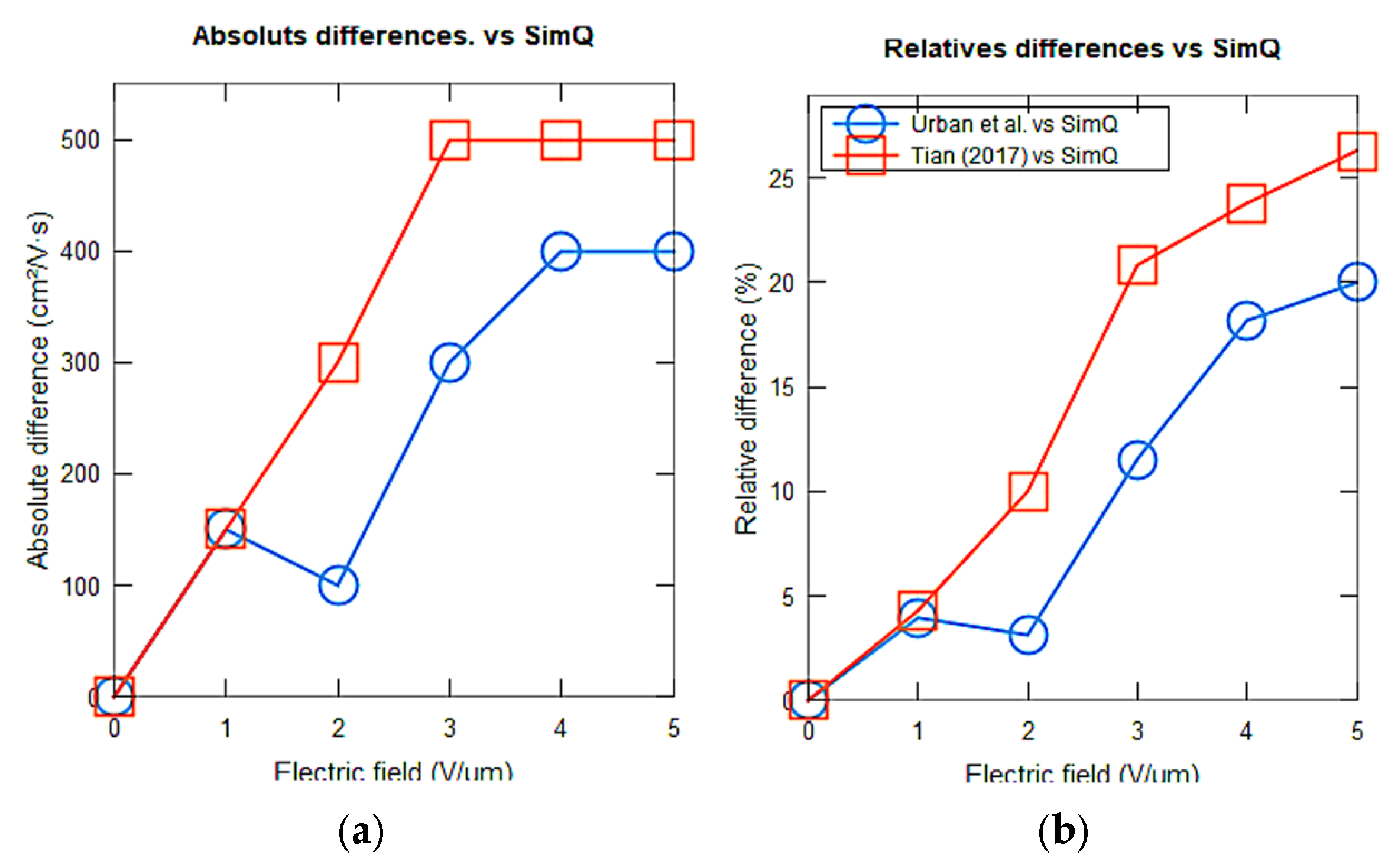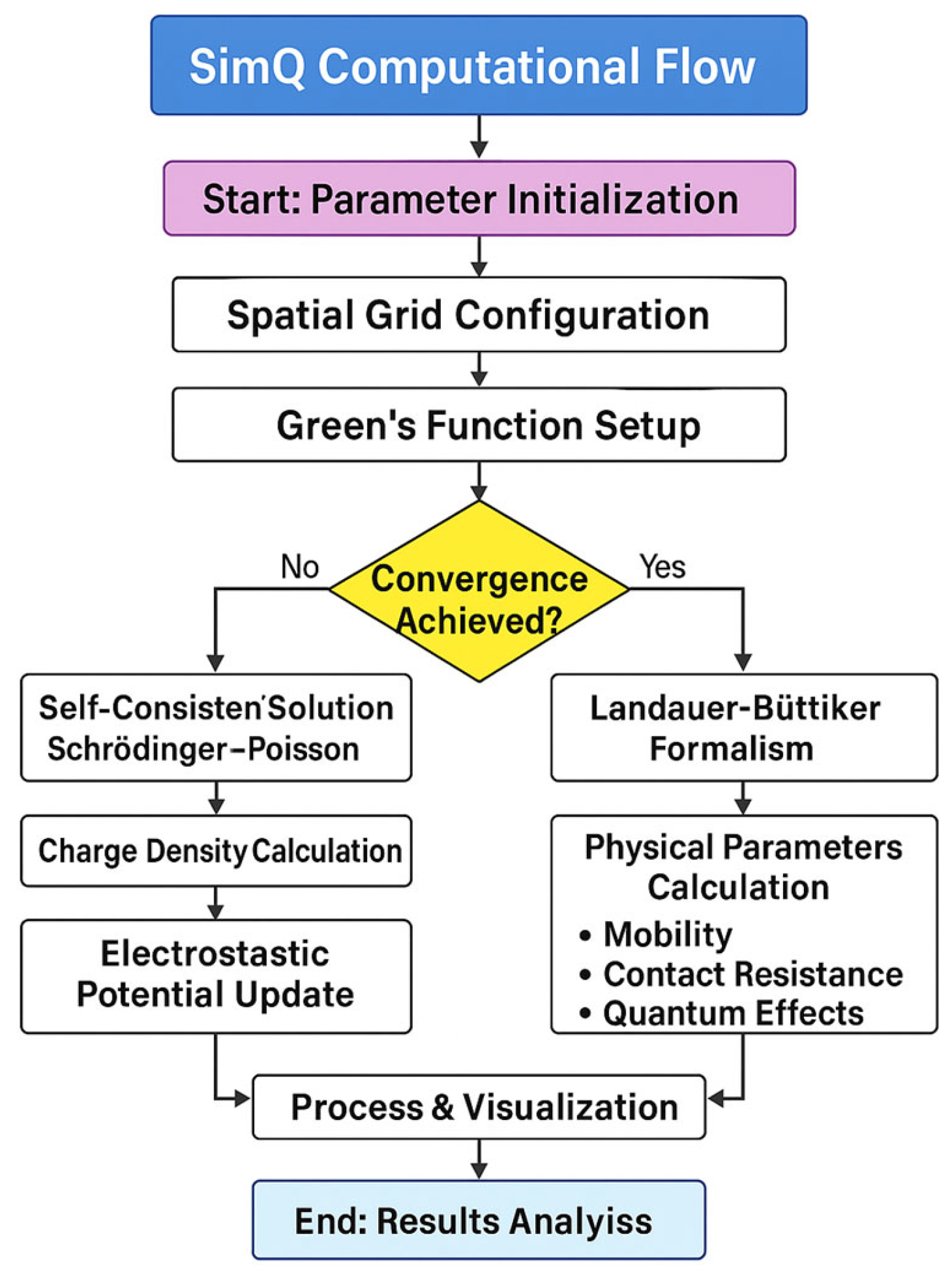3. Results and Discussion
We simulate an n-type ambipolar GFET with a back-gate configuration, consisting of monolayer graphene on
dielectric (10 nm, εᵣ = 3.9) with a heavily doped silicon substrate. The metal contacts are modeled through a parametric resistance model following
with values ranging from 1500 to 3500 Ω, consistent with experimental data [
11]. Source and drain resistances are set to 500 Ω, enabling accurate simulation of transport characteristics without specifying a particular metal type.
Figure 3 illustrates the output curves of the GFET (
Id vs.
Vd), exhibiting the fundamental aspects of the device’s behavior. The different curves for each
Vg value demonstrate the gate voltage’s ability to modulate the channel current. For higher
Vg values, the
Id vs.
Vd curves shift upward, indicating increased channel conductivity [
9,
21]. Conversely, for lower
Vg values, the curves shift downward, reflecting a reduction in the carrier density in the channel. This effective modulation of the current by the gate voltage is critical for GFET operation as a control device. Unlike conventional MOSFETs, the curves exhibit a gradual trend toward saturation at high drain voltages, which is attributable to the absence of a bandgap in graphene, continuous carrier generation under high electric fields, and the inherent ambipolar behavior of the material.
The observed currents, in the nanoampere range, are consistent with the device’s nanometric dimensions (100 nm × 240 nm). The linear behavior at low drain voltages, combined with the gradual saturation at higher voltages, suggests that the device is viable for both analog and radiofrequency applications.
Figure 4 shows the transfer curves (
Id vs.
Vg) of the device under different drain voltages (
Vd = 0.27, 0.88, 1.79, and 2.70 V). These curves show the fundamental characteristics of the GFET. The device response shows a clear dependence on the drain voltage (
Vd). For low
Vd values, such as 0.27 V, a smooth maximum current peak is observed, with a gradual transition between hole and electron conduction regions. In contrast, when increasing
Vd to 2.70 V, the maximum current increases significantly, the peak becomes more pronounced, and the response exhibits greater asymmetry.
The key characteristics of the device include the consistency of maximum conduction, remaining near Vg ≈ 1 V. Asymmetry between the positive and negative Vg regions is also observed, which can be attributed to impurities or structural variations in the graphene layer. The magnitude of the current, in the nanoampere range, is consistent with the device dimensions. This observed behavior is consistent with the unique electronic properties of graphene and demonstrates its potential for nanoelectronics applications where an efficient transition between hole and electron conduction is required.
Figure 5 depicts the electrostatic potential across the channel, which is fundamental for understanding how the gate and drain voltages influence the device’s behavior. The potential distribution, ranging from 0 to 1.5 V, shows the nature of electrostatic coupling in the GFET.
Sharper potential variations near the device edges corroborate the presence of high-contact resistance regions, a critical factor in GFET performance, as mentioned in our objectives. This electrostatic potential profile provides a better understanding of how gate voltage coupling influences device performance, a crucial aspect for GFET optimization, as discussed in the introduction [
22].
Carrier mobility is a crucial parameter that largely determines GFET performance. As shown in
Figure 6, we analyze mobility both as a function of the drain voltage (
Figure 6a) and its joint dependence on the drain and gate voltages (
Figure 6b).
A monotonic decrease in mobility is observed with an increasing drain voltage. Mobility decreases from approximately 3650 cm2/V·s at Vd = 0 V to 3300 cm2/V·s at Vd = 3 V. The degradation slope is approximately linear, suggesting a systematic relationship between the electric field and carrier scattering.
(b) Two-Dimensional Analysis (
Vd-Vg) (
Figure 6b):
The mobility map reveals the following:
High-mobility regions (~3800 cm2/V·s): Yellow-green.
Low-mobility regions (~3200 cm2/V·s): Dark blue.
Gradual transition between regions.
Physically consistent behavior.
The stabilization tendency at higher drain voltages suggests the onset of rate saturation effects, a crucial aspect in understanding the behavior of the device in high-field regimes [
13].
In summary, the analysis of carrier mobility in our modeled GFET exposes features that are consistent with the unique properties of graphene [
23]. The high mobility, especially in low fields, highlights the potential of GFETs for high-frequency and low-power applications. However, the decrease in mobility with an increasing electric field underscores the importance of considering the operating conditions in the design of graphene-based devices.
The transconductance of our GFET (see
Figure 7) is a critical parameter that indicates how effectively the gate voltage controls the current flow in the device.
Figure 7 depicts the characteristic ambipolar behavior of graphene, which is manifested through two distinct peaks in the transconductance curve. We observe a positive peak of +0.01 S and a negative peak of −0.01 S, located symmetrically around the central axis. This symmetry is a hallmark of the ambipolar nature of GFETs, demonstrating our device’s ability to conduct both electrons and holes with a similar efficiency. The magnitudes of these peaks are consistent with those expected from high-quality GFETs, indicating a good device performance. This transconductance behavior not only confirms this unique feature of the GFET, but also highlights its potential for a wide range of applications in next-generation electronics, where the unique properties of graphene can be leveraged for superior devices.
Wave function analysis provides fundamental insights into the quantum behavior of carriers in the GFET channel.
Figure 8 shows two complementary perspectives. The complex interference patterns observed directly illustrate the wave-like nature of electrons in graphene, a critical aspect for understanding carrier transport in these devices [
8]. The spatial variation in the wave function amplitude, with a higher intensity near the contacts, offers effective information about the probability of carrier localization. This directly correlates with charge transport efficiency and, therefore, with carrier mobility, a key parameter mentioned in our objectives [
21,
24]. The three-dimensional representation (
Figure 8b) offers an even, complete perspective of the spatial distribution of the probability of finding a charge carrier. The color map, where red indicates regions of maximum |ψ| amplitude, shows complex interference patterns in the x-y plane. These structures are not mere visual artifacts, but manifestations of the wave-like nature of electrons in graphene. The variations in intensity and patterns allow us to infer how charge carriers are preferentially localized in certain regions of the channel. This analysis reveals the fundamental aspects of quantum behavior in GFETs, including the interference and localization effects critical to electronic transport. The spatial distribution of the wave function has direct implications for transport efficiency and overall transistor performance.
The eigenvalue spectrum (see
Figure 9) provides fundamental information about the system’s available energy states. The distribution of these values reflects graphene’s unique electronic structure and its characteristic quantum behavior. The obtained eigenvalues, ranging from 0 to 25 eV with 100 points along the index, follow a characteristic parabolic distribution consistent with theoretical predictions for GFETs. This confirms the accuracy of our model in describing quantum effects.
Figure 10 shows the coexistence of two fundamental transport mechanisms that reflect the underlying physics of the device [
8,
10]. Landauer transmission (blue line) exhibits symmetric peaks at ±1 eV with a maximum of 0.28, while tunneling (red dashed line) reaches values up to 0.92. The resulting total transmission varies between 0.25 and 0.85, with an average of 0.55. The Landauer transmission shows characteristic double-peak behavior, with pronounced maxima at ±1 eV and a minimum near the Dirac point (E ≈ 0). This pattern reflects the band structure of graphene and arises from constructive interference by multiple reflections at interfaces, the quantum confinement of carriers, and the phase coherence of electronic wave functions. The sharp, symmetric nature of these resonances evidences the maintenance of quantum coherence during transport. The tunneling mechanism demonstrates a broader energy dependence with maxima near ±2 eV, significantly exceeding the Landauer transmission values. This enhanced tunneling behavior is characteristic of graphene and results from the absence of a bandgap, allowing carriers to traverse potential barriers with a high probability.
Table 2 summarizes the key quantum characteristics of the simulated GFET device. The current (Id) ranges from 0 to 4.8 × 10
−7 A, while the carrier density (n) shows values consistent with typical graphene devices (from 3.2 × 10
11 to 5.2 × 10
13 cm
−2). The transmission probabilities reflect the dual transport nature of the device: Landauer transmission reaches a maximum of 0.28 while tunneling transmission achieves significantly higher values up to 0.92, resulting in an average total transmission of 0.55. This highlights the significance of tunneling mechanisms in graphene’s transport properties. The eigenvalue distribution (0 to 25 eV) provides insight into the device’s energy spectrum, while the observed mobility values (3500–3800 cm
2/V·s) align with high-quality graphene devices. The quantum capacitance, ranging from 7 × 10
−10 to 1.64 × 10
−1 F/cm
2, reflects the unique electronic properties of graphene, particularly near the Dirac point. These quantum characteristics validate our SimQ model and demonstrate its capability to capture the essential quantum behavior of GFETs.
Figure 11 depicts the charge density distribution along the GFET channel. The charge density exhibits a linear increase along the channel, varying from values close to 0 to approximately 1.4 × 10
−7 C/cm
2. This linear trend, along with the observed constant slope, suggests a uniform electric field distribution along the device [
9]. Particularly interesting is the absence of significant fluctuations in the charge distribution, indicating coherent transport across the channel. This behavior is characteristic of the ballistic transport in graphene [
2,
10], reflecting the material’s quality and the efficiency of electronic transport. The observed distribution illustrates how the applied voltage affects charge accumulation, providing the device’s response to operating conditions.
Quantum capacitance, first described by Luryi [
25], represents one of the most fascinating aspects of GFET behavior.
Figure 12 illustrates the capacitance response of the GFET, which varies from 7 × 10
−10 F/cm
2 to 0.164 F/cm
2, with an average value of 0.109 F/cm
2. These values show graphene’s unique band structure and fundamental electronic properties [
26]. The characteristic shape of the capacitance curve and its variation with gate voltage reflects the device’s behavior. Particularly notable is the minimum observed near the Dirac point, precisely where the density of states reaches its lowest value [
2]. This feature directly reflects graphene’s electronic structure, with the carrier concentration experiencing dramatic changes in this region. The results show consistency with previous studies [
5,
6], validating our SimQ model and demonstrating its ability to capture the quantum nuances of the material. The smooth yet significant variation in capacitance illustrates how gate voltage modifies the electronic distribution in the transistor channel. A relevant aspect is the average quantum capacitance value of 0.109 F/cm
2. This value indicates the device’s considerable capacity to store and manipulate charge at the quantum level [
13], a fundamental feature for high-frequency electronics and next-generation devices.
As shown in
Figure 13a
, the phonon scattering rate increases significantly for energies above 0.2 eV, indicating strong electron–phonon interaction in this regime (
Figure 13b) [
27,
28,
29]. This enhanced scattering contributes to the mobility degradation observed at higher gate voltages (
Figure 13c), which also was investigated by [
30,
31]. Furthermore, the energy distribution of carriers broadens and shifts to higher energies as the drain voltages increase (
Figure 13d), further influencing the transport characteristics of the GFET.
Recent studies have analyzed the impact of electron–phonon scattering in hBN-encapsulated graphene, showing that optical phonon scattering becomes dominant at high carrier densities and elevated electric fields. These findings reinforce the importance of considering quantum-level scattering effects for a more accurate description of transport in GFETs. Phonon scattering rates were calculated as a function of carrier energy (
Figure 13a,b) using SimQ’s polar optical phonon scattering model, with a lattice temperature of 300 K and carrier density of 10
12 cm
−2. The mobility dependence on gate voltage (
Figure 13c) was obtained for drain voltages of 0.1 V. In contrast, the energy distribution effect (
Figure 13d) was analyzed for the drain voltages, maintaining a constant gate voltage of 1 V, which agrees with the theory reported by [
32,
33]. These results highlight the importance of considering phonon scattering effects and carrier energy distribution when analyzing transport in GFETs. With SimQ, we can visualize these phenomena, allowing us to gain a deeper understanding of the factors influencing device performance and providing a foundation for informed optimization strategies.
Our comparative analysis focuses on the following main reference models: the drift–diffusion model and efficient structure developed by Nastasi & Romano [
5,
6]; the Klein tunneling theory, initially proposed by Klein [
34] and applied to graphene by Katsnelson et al. [
18]; the electron optics approach by Allain and Fuchs [
20]; contact resistance and mobility [
13]; and phonon-mediated room-temperature quantum [
35].
The mathematical formulation for each model’s transmission mechanism is characterized by specific equations. The Klein tunneling model is as follows:
where
T(
E) is the energy-dependent transmission probability,
T(
θ) is the angle-dependent transmission probability,
E is the energy of the incident electron,
V0 is the height of the potential barrier,
D is the width of the potential barrier,
θ is the incident angle of the electron,
ħ is the reduced Planck constant, and
is the Fermi velocity in graphene (~10
6 m/s).
Allain and Fuchs incorporate chirality through the following:
where γ is the coupling factor (typically ~0.1 for GFETs) [
10] and
E0 is related to the Dirac point energy (
).
The mobility degradation with electric field in both the SimQ and N&R models is based on (8). We present comparisons between SimQ and these models, with a particular emphasis on
I-V characteristics, mobility behavior, and transmission mechanisms. The results obtained through SimQ show strong agreement with N&R [
5,
6], particularly in device characteristics.
I-V curves exhibit similar behavior, with currents in the nanoampere range. The initial mobility of 3650 cm
2/V·s compares favorably with the 3800 cm
2/V·s reported by N&R [
5]. Landauer transmission (0.28) and tunneling (0.92) align with reported values, while cut-off frequencies (85–95 GHz) match those found in [
6]. The main differences appear in the electric field dependence, where SimQ predicts a more gradual mobility degradation compared to N&R [
5]. At 5 V/μm, while N&R predicts 2000 cm
2/V·s, SimQ maintains 2400 cm
2/V·s, suggesting a more detailed treatment of scattering mechanisms.
The I-V curves from our model agree with the reference results. This similarity is based on key aspects of the device’s behavior. The characteristic ambipolar nature of graphene is faithfully reproduced, as well as the current magnitudes, which remain consistently in the nanoampere range. The device’s response to gate voltages and its saturation characteristics also show a notable correspondence with previous results.
Of particular interest is the comparison of the density of states (DOS), as illustrated in
Figure 14. Our model (red line) shows good agreement with the results of Nastasi and Romano [
6]; as indicated by the blue dotted line, both maintain the characteristic linear dependence on energy typical of graphene. However, our model predicts a slightly higher DOS across the entire energy range. In contrast, the model by Tian et al. [
14], shown by the black dashed line, exhibits a different behavior, with a non-linear relationship that results in significantly higher DOS values at energy extremes. This non-linear dependence is consistent with Tian’s theoretical analysis of graphene’s density of states [
14], where the DOS follows
The three models predict zero DOS at the Dirac point (
E = 0), consistent with graphene’s unique band structure. The values increase to approximately 1.0 × 10
14 cm
−2eV
−1 for our model and 0.9 × 10
14 cm
−2eV
−1 for N&R at ±0.6 eV. In contrast, the model of Tian et al. [
14] reaches approximately 1.2 × 10
14 cm
−2eV
−1 at the same energy points.
Figure 15 depicts a detailed comparison of the carrier mobility between SimQ and the drift–diffusion model developed by Nastasi and Romano [
6]. The comparison focuses on mobility degradation with the electric field, a critical parameter for device performance. The model [
6] employs a drift–diffusion formulation, where mobility follows (8), with μ
0 = 3800 cm
2/V·s,
, and α = 1.2. SimQ shows comparable behavior but with slightly different parameters (μ
0 = 4000 cm
2/V·s,
= 2.0 V/μm, α = 1.1), resulting in a more gradual degradation profile (
Table 3)
. The key differences between the models become particularly evident in the following three regions:
1. Low-field region (0–1 V/μm). Both models show similar initial mobility values and degradation rates.
2. Mid-field region (1–3 V/μm). SimQ predicts a gradual reduction in mobility, suggesting a different treatment of carrier scattering mechanisms, as detailed in [
6].
3. High-field region (>3 V/μm). SimQ maintains slightly higher mobility values (2400 cm2/V·s at 5 V/μm compared to N&R’s 2000 cm2/V·s), indicating potentially better carrier transport under strong fields
These differences reflect distinct approaches to modeling carrier transport. While N&R focuses on drift–diffusion processes, SimQ incorporates additional transport effects that may better account for carrier behavior under varying field conditions. This is particularly relevant for understanding device performance in high-field applications.
Figure 16 shows a comparison of the transconductance behavior between the different models. The solid blue line represents the results from SimQ, while the dashed lines show the results from Nastasi [
36] and our implementation of the drift–diffusion model based on [
6] (in green). The three models predict transconductance peaks close to ±0.01 S, although with some differences in behavior.
Figure 17 illustrates the transfer curves of the GFET based on the N&R model [
6] and our SimQ model. Both the SimQ and N&R models reproduce the characteristic bell shape typical of the ambipolar behavior in graphene-based field-effect transistors. However, we observe some differences. The SimQ model predicts slightly steeper current peaks and a more abrupt transition between the electron and hole conduction regions, while the N&R model shows a smoother transition and less differentiation between the positive and negative voltage branches.
Figure 18 depicts the output characteristics of the GFET based on the N&R [
6] and SimQ models. These models exhibit the typical behavior expected of a field-effect transistor, with an initial rise in current followed by a gradual trend toward saturation. The SimQ curves show a slightly higher current than the N&R ones, particularly at higher drain voltages, and a smoother transition to saturation. These differences probably reflect variations in the treatment of transport phenomena and the interaction between the channel and the contacts in each model.
Figure 19 provides a detailed overview of the comparison of transmission probabilities between the SimQ and N&R models. The results show differences in how each model treats transport mechanisms. In the energy range between −1 eV and 1 eV, SimQ predicts noticeably higher Landauer transmission probabilities than N&R, suggesting a higher efficiency in ballistic carrier transport.
Similarly, the tunneling probabilities are high in the SimQ model, indicating a high permeability of the potential barriers. This difference is particularly relevant because it suggests that SimQ captures the quantum effects in the device with better detail. The observed behavior is consistent with the ambipolar and bandgap-free characteristics of graphene, where carriers can pass through potential barriers with a high probability [
2,
37]. The comparison of the overall transmission probabilities reflects these differences, showing how the different transport mechanisms combine to determine the overall behavior of the device. These variations in transmission predictions between the two models help explain the observed differences in the electrical characteristics and overall performance of the device [
5,
6]. The coexistence of Landauer transmission mechanisms (
Table 2) suggests an operating regime where both processes contribute significantly to transport. This duality in transport mechanisms explains the observed high conductivity and the ability of the device to operate efficiently across different voltage regimes. The quantitative comparison of the key parameters, summarized in
Table 3, shows a remarkable agreement between both models. Mobility, transmission probabilities, quantum capacitance, and cut-off frequencies present differences of less than 8% in all cases, suggesting a strong consistency in the physical description of the device.
On the other hand,
Figure 20 shows a comparison of different theoretical models of quantum transmission in GFETs. The SimQ model exhibits transmission maxima at
E ∈ [−2, −1] eV and [1, 2] eV with T ≈ 0.42 near
E = 0 (see
Table 4). The Klein theory [
32] (blue dotted line) predicts a sharp minimum at E = 0 due to thermal effects, characteristic of the perfect relativistic tunneling of chiral carriers. A quadratic dependence on energy (T ∝ E
2) emerges from the conservation of helicity in graphene. The Allain & Fuchs mode [
20] (green dot-dash line) exhibits a maximum at
E = 0, highlighting the dominant role of chirality conservation at a finite temperature (300 K). The inclusion of thermal effects via
results in qualitatively different behavior compared to the other models. In summary, the comparative analysis shows that the results of the SimQ model agree with the reference models. The observed differences are principally due to variations in the approaches used to capture the quantum and transport phenomena, but they remain within a relatively small range, reinforcing the validity and robustness of the SimQ model presented in this work.
The theoretical models of Klein tunneling [
20,
34] provide valuable insights into the quantum transport mechanisms in graphene; recent experimental studies have provided crucial validation of these phenomena. Young and Kim [
19] demonstrated the direct observation of Klein tunneling in graphene heterojunctions, measuring transmission probabilities that closely matched theoretical predictions. Their experiments showed transmission coefficients of 0.4–0.5 at normal incidence, aligning well with SimQ’s predicted value of ~0.42 near E = 0. Furthermore, experimental work by Stander et al. [
16] on graphene p-n junctions reported clear signatures of Klein tunneling, with the measured conductance following the angular dependence predicted by theory. Their results showed transmission probabilities exceeding 0.3 for normal incident carriers, providing strong experimental support for the tunneling mechanisms implemented in our model. Particularly relevant to our work are the high-field transport measurements by Chen et al. [
17], who observed mobility values between 3500 and 4000 cm
2/V·s at room temperature, remarkably consistent with the SimQ predictions.
Urban et al. [
13] demonstrated experimentally that mobility is independent of gate voltage when the contact resistance effect is removed. They showed that mobility values range from 4000 cm
2/V·s at low fields to approximately 2000 cm
2/V·s at 5 V/μm, with degradation primarily attributed to phonon scattering at temperatures above 250 K. Finally, we compare our mobility results with those reported in other notable works in the field, as shown in
Figure 21. This figure reports a direct comparison between the mobility values obtained with SimQ and those reported by Urban et al. [
13] and Tian et al. [
14] as a function of electric field. All datasets show a decrease in mobility with an increasing field, but with quantitative differences. SimQ predicts a more gradual degradation compared to Urban, maintaining slightly higher mobility values throughout the considered range. Tian’s theoretical model shows more significant mobility degradation at high fields, particularly beyond 3 V/μm.
Figure 22 shows the absolute and relative differences in the electric field using the SimQ model, Urban et al. [
13], and Tian et al. [
14]. The absolute differences (
Figure 22a) increase with the electric field. The model of Tian et al. [
14] registers maximum differences close to 500 cm
2/V·s between 3 and 5 V/μm. On the other hand, the model of Urban et al. [
13] exhibits differences around 400 cm
2/V·s at high fields.
Figure 22b illustrates the relative differences in the electric field from approximately 5% at low electric fields to 20% at higher electric fields for Urban et al. [
13]. Tian et al.’s model [
14] presents a trend reaching a relative difference of approximately 25% at 5 V/μm.
Table 3 describes a comparison of the key parameters of the GFET using the SimQ model and the models of Urban et al. [
13] and Tian et al. [
14]. Our SimQ model agreed well with the results of the models of Urban et al. [
13] and Tian et al. [
14]. Comparative values were extracted from specific sections of the reference works, as follows: mobility values derived from the contact resistance and sheet resistance data presented by Urban et al. [
11] and Tian et al. [
14], transmission coefficients from [
11,
12], quantum capacitance measurements from [
11], and cut-off frequency estimations from [
12].
The implementation of SimQ in Octave demonstrates a significant computational efficiency while maintaining accuracy in transport calculations. Our performance analysis focused on the following three key aspects: execution time, computational resource utilization, and scalability. We used a standard desktop computer (Lenovo, Beijing, China, Intel i5 processor, 16 GB RAM).
Our SimQ model provides faster execution for basic transport calculations, a lower memory footprint for equivalent simulations, a greater flexibility for customization and modification, and open-source accessibility for academic research. These performance characteristics make SimQ suitable for rapid device prototyping and academic research, where both computational efficiency and flexibility are crucial.
Figure 23 illustrates the computational workflow and optimization strategies implemented in SimQ, showing the key processing stages and their interactions. This modular structure enables efficient resource utilization while maintaining accuracy in quantum transport calculations. Our SimQ model operates under idealized conditions that present important limitations for real-world applications. Future versions of SimQ could incorporate coupled thermal modeling, advanced interface treatment, and additional scattering mechanisms to bridge the gap between simulation and experimental behavior.
Table 5 provides a comparison of different parameters of GFETs using the SimQ model and GFET Lab [
38] and Atlas (Silvaco) [
39] models. While commercial tools like ATLAS offer more sophisticated physical models in some areas, SimQ provides multi-technology support capabilities that are not available with other open-source alternatives like GFET Lab or NanoHub tools. This makes SimQ particularly valuable for researchers exploring the effects of fabrication-dependent variations and defects on GFET performance.
